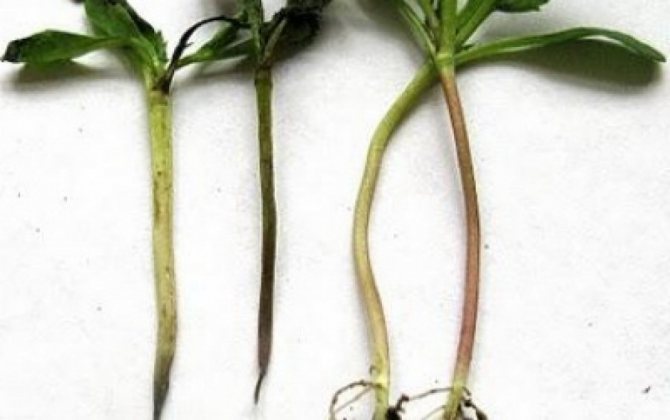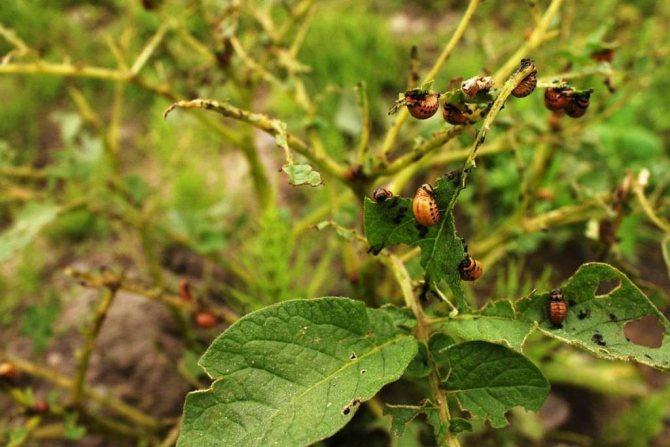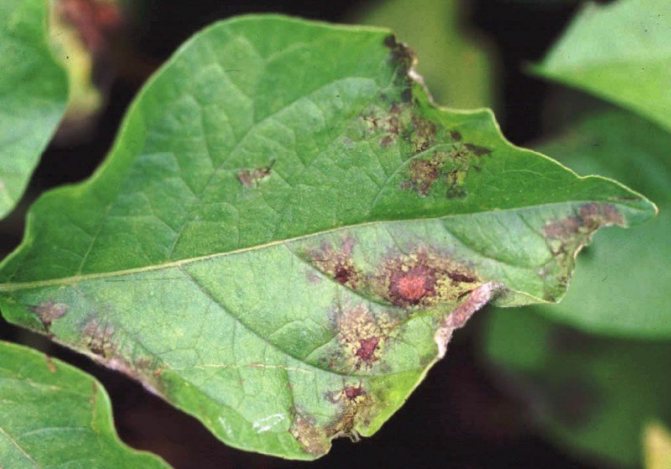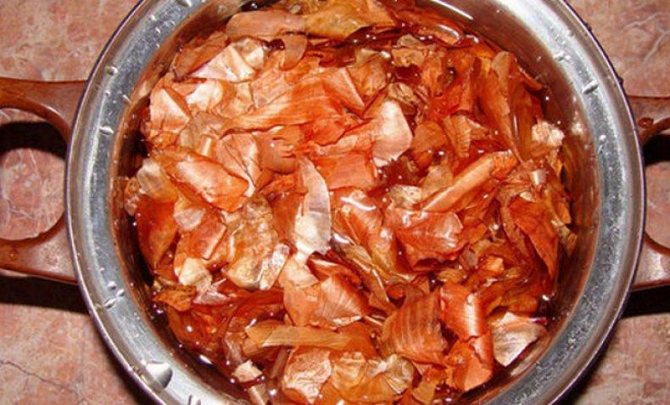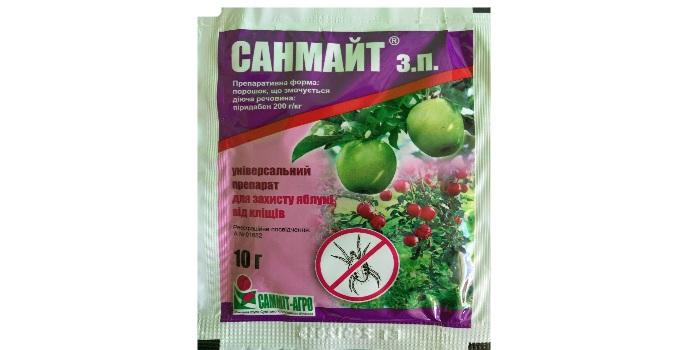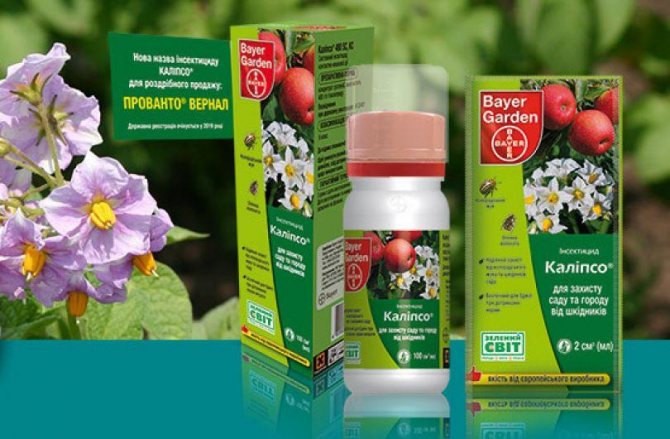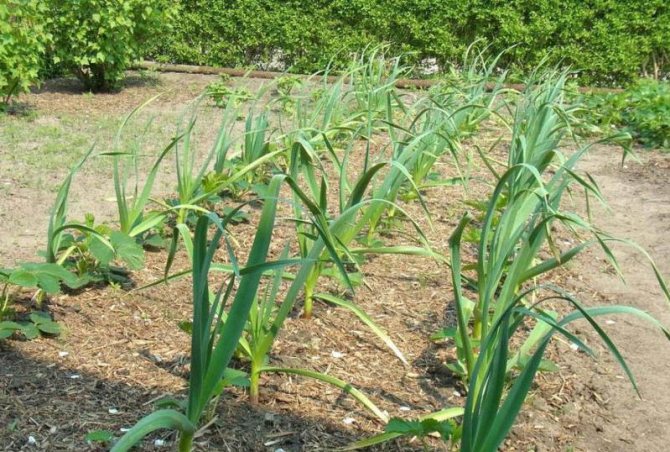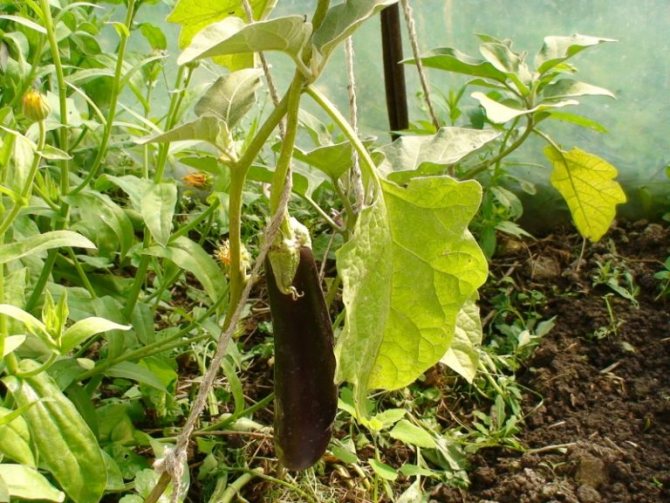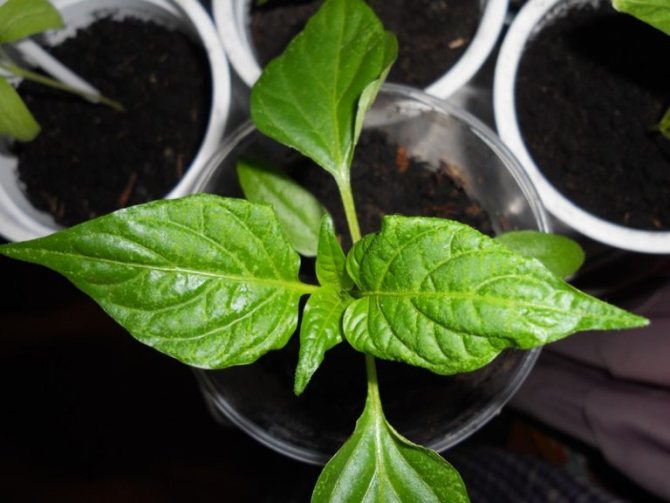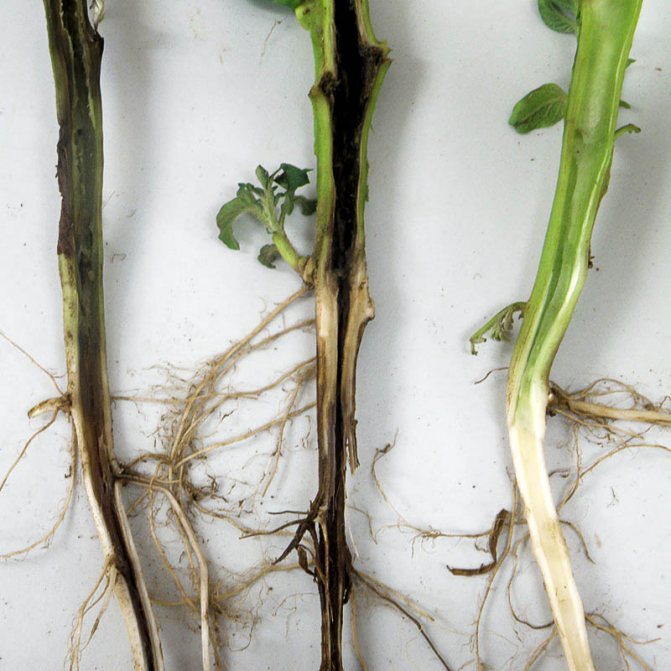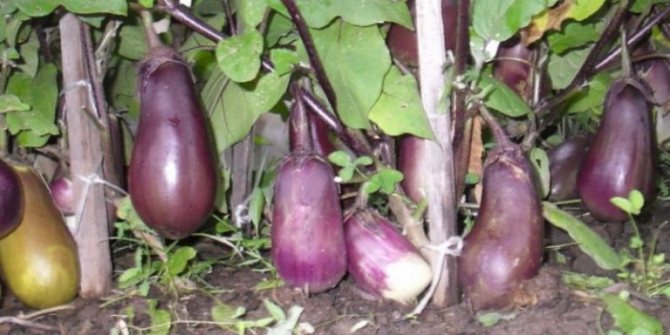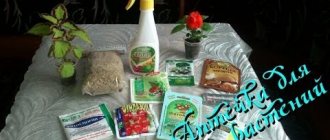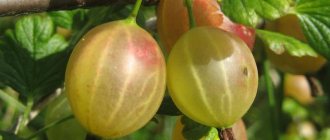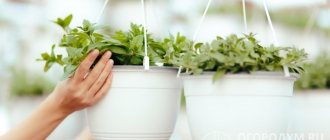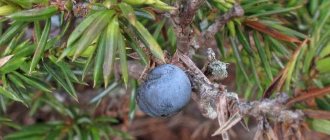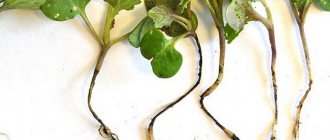Many people love different eggplant dishes, but it is impossible to grow these vegetables on their site in sufficient quantities. Either aphids start on them, then the leaves begin to turn yellow and crumble along with the flowers. Indeed, eggplant is one of the most demanding crops. For its successful cultivation, it is necessary to create optimal conditions, as well as to carry out prevention and fight against diseases and pests.
- 2 Diseases of eggplant seedlings
2.1 Blackleg
2.1.1 Video: what is a black leg
- 2.2.1 Video: one of the options for rolling leaves and its possible causes
- 2.3.1 Video: the leaves turned yellow after transplanting into the ground
- 2.4.1 Table: eggplant diseases accompanied by spotting, prevention and control
- 3.1 Table: eggplant pests and methods of control
3.1.1 Photo gallery: pests that most often settle on eggplants
Prevention against eggplant diseases
● whitefly; ● spider mite; ● aphids; ● thrips.
● Colorado potato beetle; ● scoops; ● potato ladybug.
The whitefly, despite its small size, is capable of causing great harm to the crop. Together with it, the insect can bring sooty fungi that infect eggplant leaves, gradually leading to their death. The insect overwinters in greenhouse crevices, plant remains.
The spider mite is characterized by a very small size, it is difficult to see it with the naked eye. It is possible to determine the presence of a pest by very small points on the leaves, resembling a puncture of a syringe. The insect is very gluttonous, and therefore causes great harm to the crop. To combat spider mites, it is recommended to use acaricides, insectoacaricides.
Aphids in most cases settle on greenhouse-growing eggplants. The insect is capable of destroying not only eggplant seedlings, but also other garden crops. It feeds on the juices of young bushes, inevitably leading to the death of plants. If fruits grow on infected bushes, they are characterized by bitterness and underdevelopment. The insect carries viral diseases.
Thrips are represented by the smallest insects. You can find out their presence by gray and silver spots on the bottom of the eggplant leaves. In plants, the pest lays eggs. Subsequently, the larvae feed on juices, gradually destroying the leaves. Thrips carry viral diseases.
The potato ladybug has another name - epilyakhna. The insect eats many vegetables: potatoes, tomatoes, peppers. Winters in unharvested greens of vegetables. Lays eggs on the underside of leaves.
● spider mite; ● Colorado potato beetle; ● whitefly.
The spider mite settles on the lower part of the eggplant leaf and feeds on its juices. It is possible to determine the presence of an insect by small holes in the leaves, light spots on them. Gradually, the plant curls up and dries up. To combat leaf-eating insects, Fitoverm, Envidor are used.
The Colorado potato beetle gnaws at the leaves of a bush. Control measures consist in self-collection of the insect and its destruction in a salt solution.In case of mass infection, it is recommended to use special drugs: Prestige, Calypso.
Whitefly spoils eggplant bushes grown in greenhouse conditions. You can find out about the infection by the white bloom on the leaves. Subsequently, they curl and dry. The following drugs are recommended for treatment: Fosbecid, Actellik.
Unhurried slugs seem harmless, unable to damage garden plants. But in the case of high humidity, heavy rains, they actively multiply and eat vegetables and other plantings.
Slugs prefer the fruits and greens of eggplants, they are carriers of fungal infectious diseases. Molluscs are afraid of dry weather, as well as hedgehogs, frogs that feed on them.
To combat slugs, it is important to remove weeds in which gastropods cannot hide. To reduce humidity, you need to regularly ventilate in greenhouses. It is recommended to sprinkle the paths with salt, walnut shells, since slugs prefer a flat, smooth road.
Preventive measures include following the sowing rules, disinfecting seeds and soil, and destroying infected plants. Look at the pictures for what the pests look like, and regularly inspect the plantings in search of harmful insects. It is also recommended to remove the remnants of green vegetables.
Disease prevention consists of the following measures:
- Observe the correct temperature regime.
- Use warm water for irrigation.
- Sprinkle wood ash on suspicious bushes.
- Drizzle with Planriz solution.
- Control the composition of the soil, introduce additional fertilizing and nutrients.
If improperly planted and cared for, eggplants are susceptible to pests. It is important to ensure disinfection measures even at the seed stage and to monitor the growing conditions during the ripening of the crop.
Leaves turn yellow not only in eggplant seedlings. This problem is typical for mature plants as well. Most often, yellowness appears due to unsuitable, too dense peat soil, poorly permeable to air and water. Another possible cause could be nitrogen and potassium deficiencies.
Most often, yellowness on the leaves of eggplant seedlings is caused by the use of an unsuitable substrate for this culture.
To avoid this, eggplant seeds are planted in special seedling soil. Ordinary land from the garden will not work, since the culture is very sensitive to the acid-base balance, it does not tolerate the slightest deviations in one direction or the other. Before planting in the ground, seedlings must be fed by watering with a weak solution of nitrogen and potassium fertilizers (they must be alternated).
For eggplant seedlings, it is best to use soil purchased in a store, in addition, it must be sterilized.
Pepper seedlings do not grow, stands still, what to do?
If the seedlings of cucumbers are very elongated, what to do?
Planting peas in spring sowing: when to sow, how to plant correctly?
Also, yellowness can be associated with improper watering. If the plants are exposed to the sun and watered during the day, the water droplets on the leaves act as lenses. The plant gets sunburn, the tissues in these places change color.
Yellowness is also a symptom characteristic of Fusarium. First, it affects the lowest leaves - they turn pale, then turn yellow, dry and fall off. As a rule, the pathogenic fungus spreads with infected seeds, therefore, before planting on seedlings, they must be disinfected in a bright pink solution of potassium permanganate. When planting in the ground, granules of Trichodermin, Glyokladin are added to the holes.
If the plant is clearly suffering from fusarium, it is destroyed. The remaining eggplants are treated with Falcon's solution.
Yellow leaves on freshly transplanted eggplant seedlings are normal.This is how the plant reacts to the transferred "stress". After 5-7 days, it will take root, and the alarming symptom will disappear.
The most common disease of eggplant seedlings, like other seedlings, is black leg. The fungus lives in the soil, and under favorable conditions migrates to the stem at the point of contact with the soil, clogs the vessels and blocks the nutrition of the plant. The root section of the stem darkens, after which a constriction occurs, the stem becomes thin, rots, the plant falls and dies.
Since the fungus lives in the soil, it must be decontaminated before sowing seeds. Avoid high soil moisture, acidic soils, thickened plantings, insufficient lighting, sudden temperature changes, and do not overfeed seedlings with nitrogen fertilizers.
It is possible to cure a black leg of an eggplant if the fungus has not severely damaged the culture, otherwise it is advisable to get rid of the seedlings. If you notice only a few diseased plants, remove them with a clod of earth, and be sure to add fungicides to the soil in the form of tablets, powders (Glyocladin), or in the form of water-soluble preparations (Fitosporin, Alirin, Gamair, Planriz, HOM, Previkur). In the absence of drugs, at least spill the soil with a solution of potassium permanganate or sprinkle with coal, ash, or better - a mixture of coal / ash with river sand.
Among the tracheomycotic wilt of eggplant, the causative agent of fusarium wilt of eggplant brings the greatest harm, and we will pay attention to it. It should be noted that another causative agent of tracheomycotic wilting, causing verticillosis, is also quite common, but causes less harm to eggplant plantings, and its symptoms and treatment are similar to fusarium.
This is mainly the eggplant disease in the greenhouse, which manifests itself during the period of mass fruiting. Pathogenic fungi penetrate from the infected soil into the stem, cause blockage of blood vessels and release toxins, which causes toxicosis in plants. The latter manifests itself in the form of necrosis on the leaves, wilting of the eggplant, starting from the top.
Eggplant leaves curl, turn yellow, dry out. It is also possible the penetration of fungal spores through mechanical damage to the fruit. Fusarium is activated at temperatures in the region of 22-26 degrees against a background of high humidity. Often this fungal disease of eggplant in the greenhouse becomes chronic, depleting the plants and reducing their productivity.
These pathogenic fungi are resistant to most fungicides, so all the efforts of the gardener should be directed towards preventing the disease. So, it is necessary to grow varieties that are resistant to wilt of eggplant, in case of fixing the disease in previous years, replace all the soil in the greenhouse, disinfect it in a timely manner, and also disinfect the seed material before sowing.
Black spot on eggplants manifests itself in both open and closed soil. The causative agent of this disease is bacteria. Defeat is possible throughout the growing season. It manifests itself: on the leaves - small black spots with a yellow border; on the stems - spots of an oblong shape; on fruits - first convex small dots with watery edges, which eventually increase to 7-8 cm and form ulcers.
A plant that was affected at the beginning of its development most often dies. If he manages to survive, then in the end it is still not worth expecting a good harvest and high-quality fruits.
The disease develops most actively at a temperature of 25-30 ° C, as well as at high humidity. Bacteria penetrate the fruit through mechanical damage, and into the leaves through the stomata.
How to deal with this disease? First of all, you need to monitor compliance with crop rotation. After harvesting, it is imperative to destroy all plant residues.If you do not buy planting material, but grow it yourself, collect seeds only from healthy plants. Additionally, before sowing, the seeds must be pickled.
Why do eggplants start to hurt?
Eggplants are thermophilic, so problems often arise when grown in temperate climates. If agricultural technology is violated and under poor growing conditions, the culture not only grows poorly, but also begins to hurt.
Causes of eggplant diseases:
- Lack of light. Plants should receive dosed lighting. During the period of growing seedlings, plantings cannot be highlighted around the clock. If there is little light, the seedlings begin to ache and wither, with an excess, they stretch out. The optimal daylight hours for eggplants are 10 hours. Especially a lot of light is needed for plants during the period of fruit ripening. Eggplant leaves are illuminated not only from above, but also from below.
- Moisture deficiency. The soil should always be slightly moist. It should not be dry or waterlogged. It is waterlogging that causes most dangerous diseases. In the heat, watering is carried out every other day, pouring 3-5 liters of water under each bush. In normal weather, plantings are watered 2-3 times a week. When the fruits ripen, watering is reduced to 1 time per week.
- Nutritional deficiency. The best soils for eggplant are sandy loam and loamy, with neutral acidity. On acidic low-fertile soils, plant leaves turn yellow. It is not recommended to add sawdust to the soil in order to prevent acidification. Acidic soils are deoxidized with wood ash or dolomite flour.
- Cold water. Eggplant roots should be in warm soil. Seedlings are planted in open ground only when it warms up to + 25 ... + 28 ° C. Water for irrigation should be warm and settled. Because of the cold water, eggplants get sick with fungal infections, shed their ovaries and even die.
Eggplant care principles
Eggplant care is a rather laborious and complex process due to the finickyness of the plant. Pests and diseases pose a great danger to garden crops. They can ruin the entire crop. Therefore, it is important at an early stage to identify eggplant pests and know the basics of dealing with them: you can determine the type of insect from the photo.
Eggplants are native to South Asia, where the climate is characterized by abundant rainfall and scorching sun. To obtain a high and high-quality yield, it is important to grow a crop in conditions close to South Asian conditions. Inconsistency of these requirements significantly reduces the immunity of eggplants, so they become susceptible to diseases and the actions of pests - the consequences are clearly visible in the photo. This is reflected in the quality of the crop and the taste of the fruit.
Prerequisites for changing the appearance of eggplant
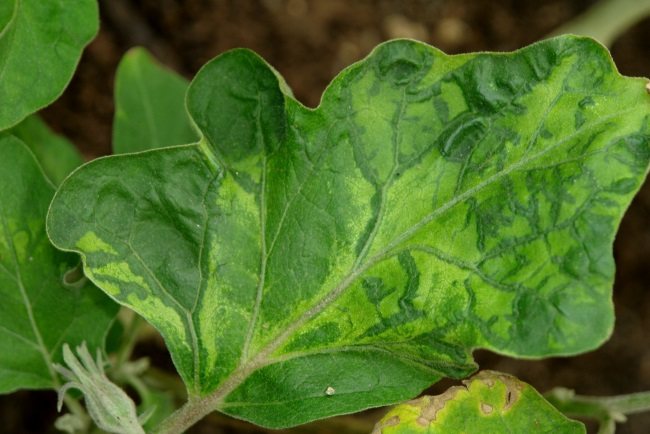
Before you start treating crops with chemicals that help in the fight against various pests, you need to make sure that the change in appearance is not the result of a gross violation of the requirements for caring for eggplants.
Growing failures and their consequences:
- The culture does not receive the necessary amount of solar energy it requires for optimal growth and development. The result of this is that the eggplants remain unripe in color (shades of brown or light). In order to prevent this problem, it is necessary to thin out the upper tier of the leaves of the plant, removing some of them, in order to ensure the unhindered penetration of sunlight to the vegetable.
- If the plant does not receive the required amount of moisture, which is especially important in hot weather, cracks form on the sides of the vegetables. Therefore, when growing this crop, it is extremely important to ensure that the irrigation regime is not disturbed.
- Falling leaves and ovaries can be the result of several negative factors: the eggplant was watered with cold water, the culture did not receive the optimal amount of moisture, and high humidity prevails in the greenhouse. The introduction of nitrogen fertilizers immediately after transplanting seedlings into the ground can also become a negative factor.
- The lack of potassium is clearly indicated by rolling leaves that take the shape of a boat with a brown edging.
- Lack of phosphorus leads to the fact that the leaves of the plant begin to stretch upward, tightly fitting to the main stem.
- If the crop does not receive the required amount of nitrogen, its leaves become lighter in color.
Pests of seedlings and adult plants
In greenhouse structures or in small greenhouses, due to the lack of regular ventilation, a favorable environment is created for the reproduction of pathogenic microorganisms. In addition, in mini-rooms, low light and high air humidity negatively affect the immune system of eggplants. Consider the most dangerous diseases of these plants and methods of their treatment.
Phomopsis
Phomopsis is a thermophilic mushroom that is the causative agent of dry rot of eggplant. The disease is expressed in the form of rounded light spots with concentric zones on the foliage, stems and fruits of plants. The disease develops at an air temperature of about 20 degrees and a humidity of 60-90%.
Methods of dealing with phomopsis:
- Presowing seed treatment.
- Spraying the bushes with fungicides.
- Removal of infected plants outside the territory.
It is also worth observing timely agricultural techniques, such as watering, crop rotation, weeding and loosening.
Late blight
Late blight is one of the most common diseases that eggplants are exposed to when grown in greenhouse conditions. The first symptoms of pathology are brown spots on the trunk and leaves of plants. Then a whitish bloom is observed on the underside of the tops. Over time, the plants dry out, and the fruits begin to deteriorate with hard rot.
There are several ways to treat eggplant for late blight. However, according to experienced gardeners, the following folk method is considered the most effective:
- Pour 200 g of chopped garlic into 3 liters of water.
- Insist the garlic solution for 2 weeks in a dark place.
- After this time, dilute the infusion in a 1: 1 ratio with water.
It is recommended to spray all the plants with the resulting liquid, and sprinkle the soil with wood ash.
Alternaria is dangerous for eggplants both outdoors and indoors. First of all, the lower fruits are exposed to these diseases, which get water during soil irrigation. In addition, there is a possibility of infection during a long period of eggplant ripening.
Alternaria symptoms are characterized by gray or brown spots on the leaves. There are cases when eggplants themselves are affected by this disease.
Alternaria is treated with contact fungicides. Spraying is carried out with a spray bottle so that the solution falls on the undersides of the leaves.
Sclerotinosis is a fungal disease that spreads in the ground. Most often, the occurrence of this disease is fog, prolonged rains, thickening of plantings.
Dark spots begin to appear on the stems and leaves of the vegetable, and the fruit itself acquires a softened structure. Over time, eggplants become slimy with white spots.
Treatment of sclerotinosis is carried out in the following order:
- The damaged parts of the eggplants are removed.
- The cuts are processed with wood ash.
- Plants are fed with complex fertilizers.
Then it is recommended to ventilate the greenhouse and warm it up until the dampness disappears.
Cercosporiasis
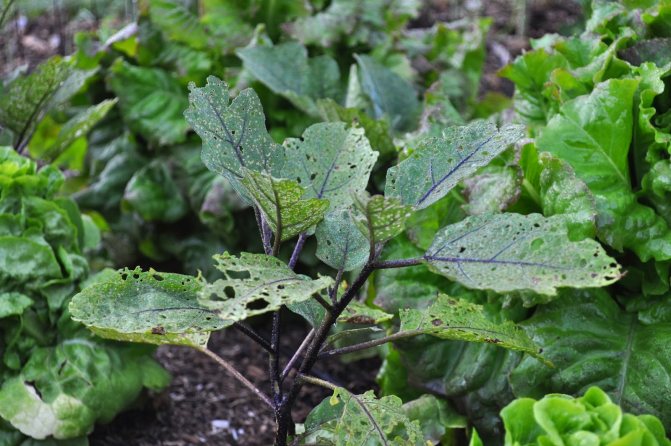

This fungal disease from the genus Hyphomycetales is transmitted by spores when the soil is irrigated, working equipment or by wind. At the initial stage of cercosporia lesions, white spots with small veins on the leaves, stem and peduncles appear in eggplants. In later periods, the foliage of the plants dies off completely, the fruits acquire a non-marketable appearance and lose their taste.
Treatment of cercosporia involves the use of Bordeaux liquid or another fungicide. Complex mineral fertilizers will also help to increase the resistance of eggplants to this fungal disease.
Phytoplasmosis
Phytoplasmosis is a viral disease that is dangerous for eggplants when grown outdoors. However, there are cases when this disease harms plants and greenhouse buildings. When infected with stolbur in eggplants, the bush deforms. The leaves become smaller and become white or purple. The stalk of the plants grows stiff, the inflorescences change their color and regular shape.
This disease is usually treated with insecticides. Eggplant processing is carried out 2 times with an interval of 13-16 days. In this case, all heavily affected bushes must be removed, and the earth must be disinfected.
Some diseases affect vegetables even in the seedling stage. This is due to poor soil or seed treatment prior to planting. You can understand that the future plant is infected by the leaves, which begin to turn yellow. In the future, such seedlings die. To avoid early spoilage of the eggplant, it is important to protect the seeds from pests.
Before planting, it is recommended to decontaminate the seeds:
- Disinfect in a solution of potassium permanganate for 20 minutes.
- Rinse the eggplant seeds in cold water.
- Pour boiling water over to remove essential oils from the surface.
- Soak in nutrient solution for 24 hours.
At the end of the protection measures, it is recommended to rinse the seeds again with water in order to remove the residues of unnecessary substances. Place on wet germination mat.
A dangerous pest can damage the crop, so it is important to fight insects in a timely manner. Due to the visibility of the Colorado potato beetle, it is harvested by hand in a separate container. Then the insects are destroyed in kerosene or saline. The collection is recommended in the morning and in the evening.
● Calypso; ● Prestige; ● Fitoverm; ● Colorado; ● Aktara; ● Regent; ● Bicol.
To protect eggplants from the attack of the Colorado potato beetle, it is recommended to put plastic bottles cut to size on the bushes. Plant calendula, celery, dill nearby, repelling the pest. Effectively dust eggplant bushes with ash, spray with wormwood tincture. These are the safest ways for vegetables.
Viral infections
Unfavorable weather conditions can cause the development of many eggplant diseases, especially if they grow outdoors.
Viral infections will not only cause great damage to the crop, but can easily destroy all plantings of vegetables. It will not be possible to cure the plant, so it is immediately destroyed before it infects the rest of the bushes.
The most common virus is mosaic.
Tobacco mosaic
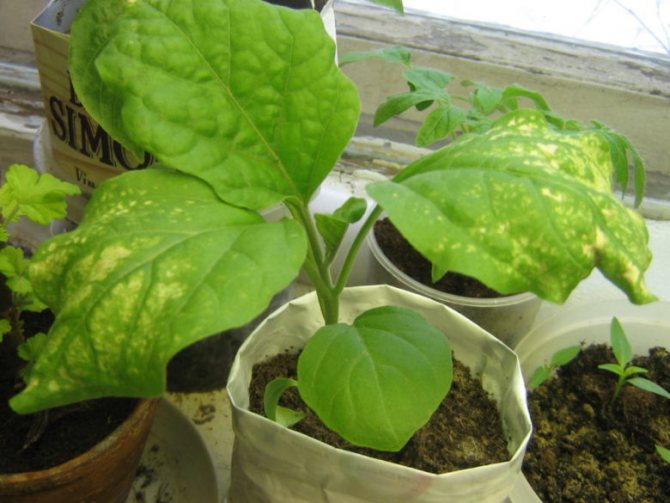

Plant mosaic
It is easy to recognize this type of virus by the mosaic-like spots that appear on the leaves of eggplant. Yellow-green spots with original patterns cover the leaves. Yellow spots appear on the fruits. Gradually, the spots grow, causing tissue death, and then the death of the culture.
This virus lives in soil, plant debris, and infected tools. Diseases and pests of eggplant can be interrelated, for example, the mosaic virus can be transmitted by insect pests.
It is impossible to cure a diseased plant; it must be destroyed immediately. The top layer of soil under the diseased bush is removed, and this place is treated with ash at the rate of a glass for a bucket of water. The rest of the plantings, which have not yet become infected, are sprayed with a solution of whey or milk. A liter of whey or milk is diluted in 10 liters of boiled water.
To prevent pests from spreading the mosaic, plant scented flowers such as marigolds around the edges of your eggplant beds. With their aroma, they scare away harmful insects that carry infections.
Phytoplasmosis or Stolbur is also considered a dangerous viral infection.
Phytoplasmosis (Stolbur)
This virus is common in vegetables grown outdoors. You can find out the disease by the following signs:
- Leaves turn purple or purple-reddish;
- The foliage at the tops of the shoots becomes tough, corrugated, cracked;
- Eggplant flowers change their shape, dry out, and then fall off the bush;
- The fruits become tough, hard, and deformed.
The plant cannot be cured; it must be immediately removed away from the site. But the disease can be prevented. It was revealed that the virus hibernates in the root system of perennial weeds. Therefore, it is important to remove all weeds from the beds, especially bindweed. Treat the soil with weed control chemicals in advance. Before planting, the soil must be clean of all plant residues.
The vectors of the virus are leafhoppers. Fight harmful insects with insecticides such as Actellik and others.
Unfortunately, no varieties have yet been developed that are resistant to this virus.
As you can see, the diseases in this culture are many and often affected by plants growing in the open air. Diseases of eggplant in the greenhouse are much easier to avoid, because there you can create suitable climatic conditions.
But even outdoors, you can reduce the risk of disease by carrying out the necessary preventive procedures.
Phomopsis, or soft rot of eggplant fruits
The remains of diseased plants, air and soil are sources of contamination of healthy eggplants. The fungal disease progresses actively in conditions of high humidity and temperatures of about 20 degrees. Increasing dark water spots on all parts of the plant soon become covered with a grayish bloom.
The treatment of eggplant from gray rot is carried out with the help of specially created fungicides, soil fumigation. If it was not possible to cure the eggplants, they must be destroyed by burning.


After the eggplant crop is harvested, all plant residues from the garden should be removed.
Sclerotinosis is a fungal disease that occurs mainly due to waterlogging of the soil and watering with cold water. Cold weather also affects when planting seedlings in the soil. The root system of the eggplant is affected. The stems acquire foci with a whitish coating, the inner part of which contains solid sclerotia.
Sprinkling with crushed chalk or wood ash helps. It should be remembered that watering should be carried out with warm water and not become excessive.
Basic information about the disease. The disease is rarely found in greenhouses, and mainly in hot weather. All organs of the plant are affected at all stages of development. Seed infection leads to seedling death and seedling lodging. Spotting of stems and leaves weakens the plant, resulting in a decrease in the number and weight of fruits.
Optimal conditions for the growth and reproduction of the pathogen, as well as for infection, are temperatures in the range of 27 ... 35 ° C and air humidity of at least 50%.
Protection measures. Most or all of the eggplant varieties are believed to be susceptible to the disease, but sources of genes for resistance to this disease exist. Due to the fact that a detailed assessment of varieties for resistance to Phomopsis has not been carried out, early varieties and hybrids are cultivated for which the damage from the disease is small, for example, the F4 Nancy hybrid or the Alekseevsky variety.
Agrotechnical methods of protection: the use of healthy seed material, the destruction of plant residues and the observance of crop rotation.
Chemicals. The plantings are sprayed with fungicides: Bordeaux mixture, preparations based on mancoceb, chlorotolonil. It is generally accepted that drugs based on carbendazim, tebuconazole and prochlorase are most effective in the fight against phomopsis.
- Plants are affected at all stages of development. The most harmful are lodging of seedlings and soft fruit rot.
- The pathogen persists in seeds and plant debris.
- The disease develops in hot weather.
- To prevent the disease, it is necessary to use healthy seeds, destroy plant debris and observe crop rotation.
Among the dangerous insects that directly affect the fruits of the vegetable are aphids. The pest sucks nutritious juices from the eggplant, infects flowers and leaves. Gradually, the plant dries up, withers and dies.
Vegetable fruits also attack naked slugs. In order to avoid their attack on the crop, it is necessary to process eggplants from dangerous pests with slaked soda, lime, tobacco dust, ash. It is recommended to pollinate nightshades with red and black pepper.
The disease is fungal and is transmitted through seeds, soil and plant debris. Phomopsis affects eggplants at different stages of development:
- If the seeds are infected, the seedlings turn brown and die.
- In the seedling period, brown, sharply outlined round spots appear on the leaves. The plant does not receive enough nutrition, the crop grows very modest.
- Phomopsis develops on fruits both during their growth and during storage and transportation. Small, but expanding, depressed brown spots appear on the surface.
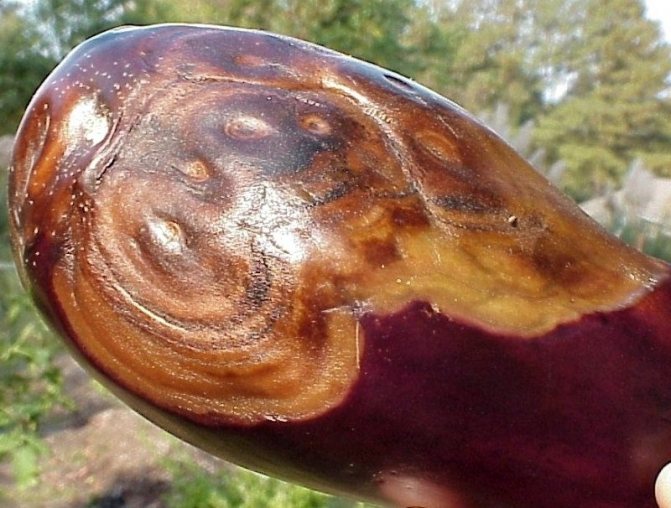

Phomopsis at a late stage of development, rot has engulfed the entire fetus
Fungi spread especially actively in greenhouses at high temperatures and humid air, but they can settle on eggplants and in the open field. The means of prophylaxis are classic: disinfection of soil and seeds, cleaning from greenhouses and from a plot of plant residues. Of the fungicides, it is recommended to use Fundazol (10 g per 10 l of water), Derozal (5-7 ml per 10 l), Spartak (20 g per 5 l). You can use Bordeaux liquid.
Having received an excellent eggplant harvest, especially in the conditions of central Russia or Siberia, you can safely call yourself a professional. After all, you learned and were not too lazy to prepare the soil and seeds well, carefully watched your plants, looked after well, noticed the invasion of fungi and pests in time, and successfully fought them. For those who have mastered the demanding eggplant, growing other crops will seem very simple.
Dangerous diseases
For the future eggplant harvest, not only pests are dangerous, but also pathogenic fungi, bacteria, viruses. There are still no effective means to combat some of them, so in no case should we forget about prevention.
Phomopsis (dry rot)
This fungus most often attacks eggplants growing in open ground, but greenhouse plantings are not immune from it. Heat and high humidity contribute to its spread.
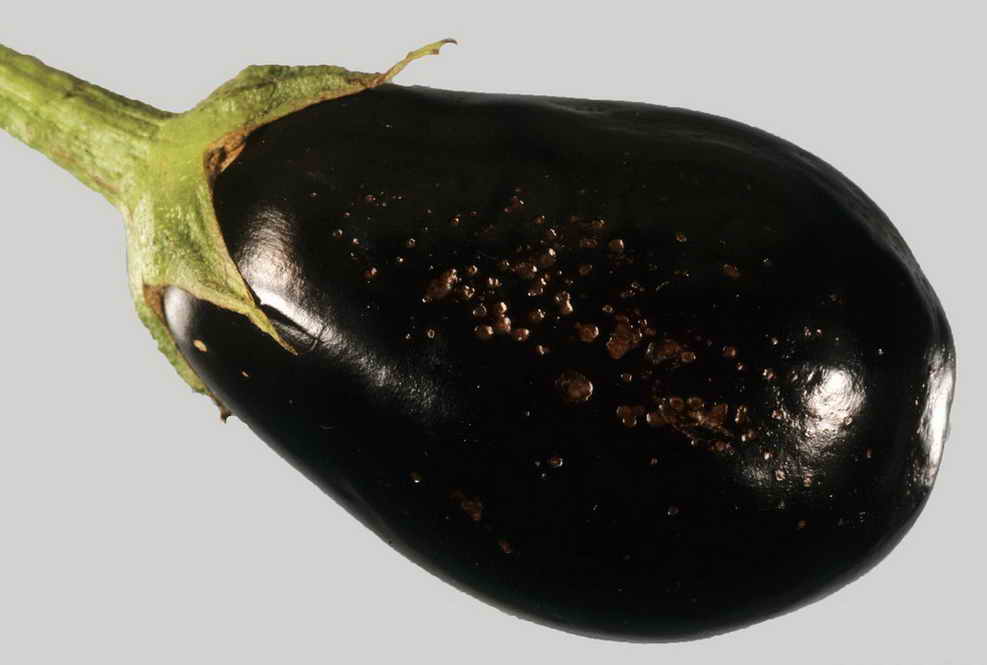

Eggplant affected by Phomopsis rots quickly enough
Closer to the base of the stem, a “weeping” dark brown ring appears, the leaves are covered with almost black sharply outlined round specks with a beige-yellow center. Gradually, black grains appear in these areas - accumulations of fungal spores. Fruits are the last to suffer. Dry brownish "dents" appear on the eggplants, from which brown mucus begins to ooze over time. The pulp under them turns black, the fruit completely rots.
For prophylaxis, the seeds must be disinfected in a solution of potassium permanganate before planting. Bushes before flowering and 7-10 days after it are sprayed with Mancozeb, Carbendazim.


Bordeaux liquid helps fight phomopsis in the early stages of the disease
When the first signs of the disease are detected, eggplants are treated with 1% copper sulfate or Bordeaux liquid. The garden bed is watered abundantly with a bright pink solution of potassium permanganate. If this does not help, any fungicide is used 2-3 times with an interval of 7-12 days (Oleocobrite, Strobi, Kuproksat).
Late blight
One of the most common and dangerous fungal diseases affecting eggplant.First, small brownish-red spots with a yellow-green border appear on the leaves, then the disease spreads to the stems. The reverse side of the sheet is covered with a thin layer of whitish "fluff", they turn black and dry. On fruits, late blight manifests itself in the form of indistinct dark brown spots. The pulp under them dries out and becomes denser, rot begins to develop. Spores of the fungus spread mainly with drops of water - this is facilitated by frequent rains, abundant dew, fogs.
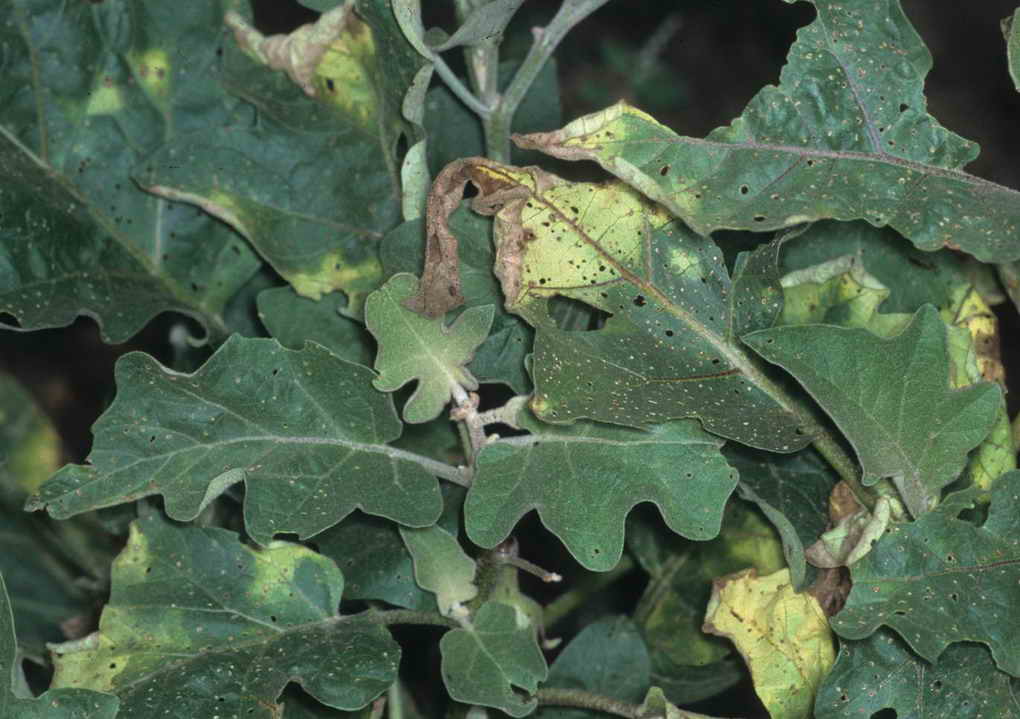

Late blight is one of the most dangerous diseases not only for eggplant, but also for all members of the Solanaceae family.
The best prevention of late blight is observance of crop rotation, placement of beds with eggplants away from plantings of other solanaceous plants and the correct planting scheme without excessive thickening. Excessive application of nitrogen fertilizers is also dangerous - this macronutrient greatly reduces the immunity of the plant.
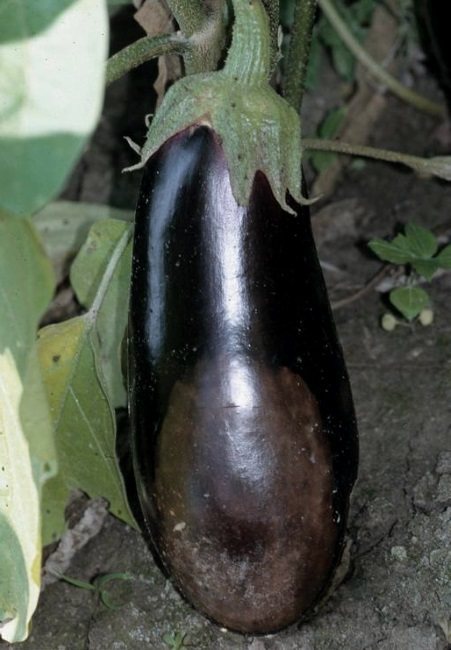

Eggplant fruits affected by late blight are not recommended
Most folk remedies against late blight are ineffective. An exception is a solution of sodium chloride (100 g per 5 l of water), kefir (1 l per 10 l of water), garlic infusion. Salt is a good antiseptic that suppresses the activity of the fungus, kefir creates an acidic environment that late blight does not like very much, garlic actively releases phytoncides.


Common table salt is a good antiseptic that inhibits the enzymatic activity of pathogenic fungi
For prevention, eggplant seedlings are sprayed with Quadris, Antracol. The bushes before flowering, a week after it and another 15-18 days are treated with Ridomil Gold, Acrobat, Mancoceb. During the season, you can use drugs of biological origin 2-3 times - Fitosporin, Baktofit. Having found the first suspicious symptoms, they use HOM, Tridex, Thanos.
Experienced gardeners recommend wrapping copper wire around the stem of the eggplant or burying a small piece of it under each bush. Copper ions have a very negative effect on the pathogenic fungus. From the soil, they enter the plant tissues with water.
Late blight of eggplant
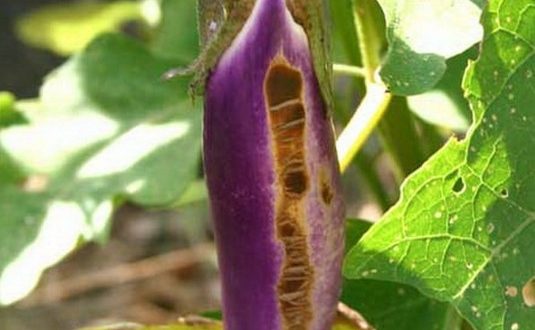

Late blight is one of the main and dangerous enemies for many plants. When phytophthora affects eggplant leaves, rusty spots appear on them, then they increase and move to the stem, after which they get to the fruits themselves. The plant begins to hurt a lot and dies. In dry hot weather, the affected eggplant leaves fall off, and in wet weather, rapid decay begins. Frequent changes in temperature will increase the rate of infection and plant death.
If tomatoes and potatoes grow nearby, then late blight may first appear on them, and after 7-14 days it will reach the eggplant.
Protection measures. Planting healthy planting material. Immediately after harvesting potatoes, tomatoes and eggplant, remove the tops and any other plant residues, spraying with copper-containing preparations (Bordeaux liquid) in the evening until the evening dew appears. An effective remedy for the fight against late blight on eggplants, spraying with an infusion of garlic (for 3 liters of water, 1 cup of chopped garlic should be infused for 10 days), previously diluted with water 1: 1. the affected plants are powdered with wood ash.
Black bacterial spot of eggplant
Black spot on eggplants manifests itself in both open and closed soil. The causative agent of this disease is bacteria. Defeat is possible throughout the growing season. It manifests itself: on the leaves - small black spots with a yellow border; on the stems - spots of an oblong shape; on fruits - first convex small dots with watery edges, which eventually increase to 7-8 cm and form ulcers.


A plant that was affected at the beginning of its development most often dies. If he manages to survive, then in the end it is still not worth expecting a good harvest and high-quality fruits.
The disease develops most actively at a temperature of 25-30 ° C, as well as at high humidity. Bacteria enter the fruit through mechanical damage, and into the leaves through the stomata.
How to deal with this disease? First of all, you need to monitor compliance with crop rotation. After harvesting, it is imperative to destroy all plant residues. If you do not buy planting material, but grow it yourself, collect seeds only from healthy plants. Additionally, before sowing, the seeds must be pickled.
Eggplant mosaic disease
Mosaic is one of the dangerous viral diseases of eggplant, which farmers have to fight every year. As you can see in the photo, it is not difficult to notice the bright green mosaic color on the plant. If fruits are involved in the process, then yellow spots appear on them. The virus is dangerous in that it leads to the death of the entire bush.
The virus enters the tops from plant debris, contaminated tools, and is carried by insects. According to virologists, the mosaic can persist in greenhouses, plant residues and harvesting equipment for several years. Therefore, all mosaic plants must be destroyed, and the garden tools used in the treatment of the beds must be disinfected.
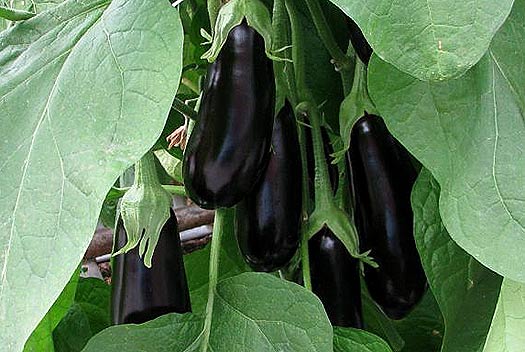

It is extremely difficult to destroy the virus. It is recommended to adhere to the rules of crop rotation, use disinfected seed, and burn plant residues in the fall. Spraying eggplant with skim milk and diluted laundry soap is considered a popular folk prevention method.
Reasons for defeat
The main cause of illness and death is improper care during cultivation. The path to the plant opens up to various pathogens and parasites.
How often the problem occurs depends on the following factors:
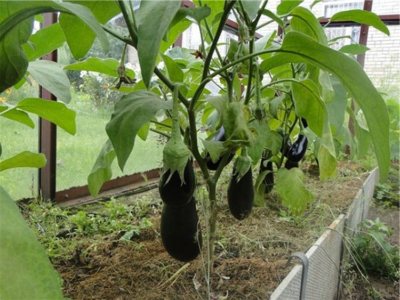

- Lack of sunlight provokes a color change in the plant itself. The skin of the fruit becomes pale.
- Improper watering. It should be regular. If these conditions are not met, then deep cracks will appear on the fruits.
- The atmosphere in the greenhouse is too humid.
Damage to eggplant can be caused by improper feeding:
- Lack of potassium (leaves turn brown at the edges).
- Lack of phosphorus - the leaf plate is stretched.
- Low nitrogen - the leaf changes its shape and color (noticeable lightening).
Destruction of the bear
Medvedka rarely comes to the surface so as not to be noticed. The insect makes winding transitions in the ground.
The insect reaches a length of 8 cm. Medvedka has powerfully developed limbs, with which she is good at digging holes in the ground. The tail of the pest is forked. The bear feeds on the roots of eggplants and other vegetable crops.
The damaged bush wilts and gradually dies.
Control measures
It is possible to destroy the bear with the help of crushed eggshell diluted with vegetable oil. Garlic planted in the hole in front of the eggplant repels the pest.
An effective method is to use beer, which must be poured into the insect's burrows. A solution of washing powder with water gives a similar result. The chemical preparation Phenaxin will help to destroy the bear. The granules of the agent must be poured into the insect's holes. After eating the drug, the pest dies.
In the fall, it is recommended to scatter manure around the garden. Medvedka will think that this is a great shelter for the winter. When severe frosts hit, dig up the dung heaps and scatter around the entire perimeter. The insect will die from the cold.
Signs of mistakes made when growing
If you are growing eggplants in a greenhouse, then the use of chemicals for pest control is limited, in this case you can use only safe drugs and strictly observe the dosage that is indicated in the instructions for them.
An effective method of preventing the development of many diseases when growing eggplants in a greenhouse is to hold the seeds before planting for 20 minutes in a weak solution of potassium permanganate.


Signs of improper eggplant cultivation:
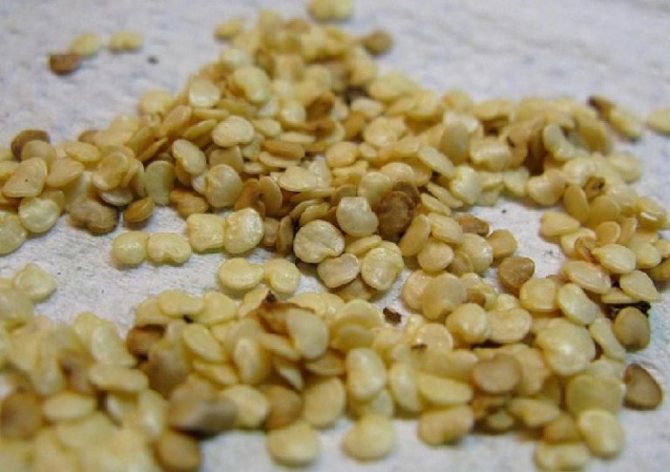

Spider mite: description and fight
A fly-sized insect feeds on plant juices, harmful to eggplant fruits and seedlings. Aphids create symbiosis with garden ants. The crop can be saved only by complete disposal of a dangerous pest.
To combat aphids, it is recommended to spray the eggplants with a solution of wood ash. It is effective to use a solution of onions with garlic, infused in warm water, or a decoction of yarrow. You can apply a composition of mustard powder with water to eggplants or spray from a bucket with 1 spoon of ammonia diluted in water.
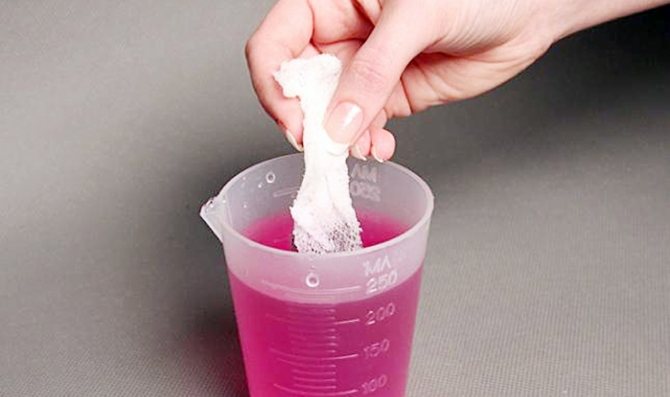

The smallest of all pests, smaller than a midge. Lives on the bottom of the leaves and feeds on their juices. To understand that there is a tick on the eggplant is possible only through the cobweb.
Saliva that has penetrated the plants destroys them, as evidenced by the clarification of the leaves. Gradually, the bush falls off, the fruit becomes smaller. Due to the fact that the pest moves along its own web, it infects eggplants in the nearest perimeter.
The mite does not tolerate moisture well, it is recommended to sprinkle the eggplant with water. The pest is afraid of ablisei and phytoseiulus, which are sold in flower shops. These individuals are capable of eating up to 6 spider mites per day.
● Fitoverm; ● Neoron; ● Sunmight.
The insect prefers warmth. It affects healthy, young bushes. The whitefly lays eggs on plants. The larvae that hatch after a couple of weeks immediately begin to feed on eggplant juices. Gradually, the plant will wither, wither and die.
It is recommended to periodically conduct a thorough inspection of the plants when picking, especially the lower part of the leaves. The insect reacts sharply to fuchsia and hibiscus, so these flowers can be bred nearby for bait.
A trap with an attractant works well against adult whiteflies. You can also rinse the eggplant leaves with a solution of laundry soap. It is better to shoot the larvae by hand.
Very often, eggplants suffer not only from various diseases, but also from pests. If the plants are not protected in a timely manner and control measures are not taken, gardeners will not get a good harvest.
Slugs
These gastropods actively eat both bushes and eggplant fruits. Their active reproduction is served by frequent rains and thickening of plantings. These pests can be identified by the large holes in the plants and by the mucus that they leave when moving.
Slug control methods:
- Remove weeds in a timely manner.
- Ventilate greenhouse structures regularly.
- Sprinkle the paths and paths with coarse salt or sand.
- Mulch the soil with spruce needles.
- While loosening the soil, sprinkle with black or red pepper.
In cases where the above methods do not give a positive result, you can use metaldehyde. For this, this powder at the rate of 3 g per 1 sq. m it is recommended to sprinkle the paths in the aisles.
Insects such as cruciferous fleas can be active in almost all areas of the infield. However, they do not tolerate shaded and humid places. Eggplant leaves are attacked by these small black insects. In a short period, cruciferous fleas are able to destroy all the greenery of the bush, leaving only streaks.
In the fight against cruciferous fleas, dandelion or garlic infusion is used. In order for the liquid to adhere well to the plants, it is recommended to add shavings of laundry soap to it.
On the territory of our country, there are several species of aphids that feed on eggplant juices. Their color can be varied, from dark black to bright red. But despite this, the methods of dealing with them are identical.
Home methods for exterminating insects:
- Laundry soap shavings are dissolved in water. The resulting solution is applied to plants 2 times with an interval of 1 week.
- In a 1: 1 ratio, mix edible salt and soda. Water and laundry soap are added to the resulting mass. The resulting mixture is sprayed with eggplants once every 3 days until the insects disappear completely.
From professional means, gardeners are advised to use biological products that do not contain harmful chemical components.
Whitefly
Insects such as whiteflies cause significant damage to eggplants. First, they absorb large amounts of plant sap. Secondly, whiteflies secrete dangerous dew, which contributes to the development of a sooty fungus.
Insects are easy to spot. As a rule, the midges themselves and their larvae are located on the back of the leaves.
If the whiteflies have not yet had time to lay the larvae, a soap solution from tar soap is used in the fight against them. In the presence of children, it is recommended to use drugs that include avermectins.
Colorado beetle
Colorado beetles are quite voracious pests. For 1 month, one female eats more than 4 g of greenery, the larva is about 1 g. In this case, each female lays about 700 eggs in one season. Therefore, if the pests are not destroyed in time, gardeners will be left without eggplants.
The following methods are used without chemistry:
- Collecting beetles and larvae by hand.
- Dusting plants with wood ash.
- Spraying with soapy water.
You can also use repellent plants, which scare off Colorado beetles with their smell. Among them, the most effective are: marigolds, calendula and celery.
Spider mite
Spider mites are considered the smallest pests for eggplant. Their size does not exceed 0.5 mm. But despite this, they cause great harm both to the plants themselves and to their fruits.
The following signs will indicate the presence of a spider mite on eggplants:
- white spots on the sheets;
- drying of the tops;
- a cobweb forms under the bushes.
If, when a spider mite is found, you immediately start fighting, then you can do without chemicals.
To destroy insects you will need:
- Increase humidity.
- Remove all damaged plant parts.
- Tear off all the available web.
For a quick effect, plants can be sprayed with ammonia diluted in water.
Medvedka
Medvedka is an underground insect that is difficult to see. It is possible to understand about the presence of this pest only by the holes and trenches made in the ground. The insect feeds exclusively on the roots and aerial parts of eggplants.
You can get rid of the bear in the following ways:
- Lay out egg shell and vegetable oil baits on the site.
- Pour insect burrows with a solution of 150 ml of kerosene and 10 liters of water.
The destruction of pests also involves the use of a highly toxic drug - "Phenaxin". Its granules are poured into places where there is a large accumulation of insects.
A set of measures to prevent the development of diseases:
- Seed processing.
- Disinfection of soil and greenhouses.
- Ventilation of greenhouse structures.
- Timely watering.
- Removing weeds as soon as they appear.
- Top dressing with complex fertilizers.
- Pest control.
- Loosening the soil.
Also, eggplants cannot be planted in one place annually. The best predecessors for them are: peas, beans, cucumbers, cabbage.
As you can see, when growing, eggplants require special attention and adherence to the rules of agricultural technology. Without proper care, they are exposed to various diseases and insect attacks. But if you make an effort, then every gardener will definitely get the desired result of the yield of tasty and healthy fruits.
What a cruciferous flea looks like and how to get rid of it
The insect is black, oval in shape with a shiny surface can exist throughout the garden plot. Sometimes there is a pattern on the back. The flea does not tolerate shade and high humidity. The pest infects eggplant leaves, destroying the greens in a short time.
The cruciferous flea larvae feed on plant roots, leading to their death. As for the description of appearance, hatched insects can be recognized by their thin, elongated body with a yellowish tinge.
To get rid of the pest, gardeners use garlic or dandelion tinctures. For better adhesion of the solution to the leaves, it is recommended to add shavings of laundry soap.
Development of bacterial diseases
If the plant is infected with black bacterial spot, then all of its parts suffer, and this can happen at any stage of development. Black dots appear on the leaves, surrounded by a yellow rim, on the stems such spots have an oblong shape.
The fruits are covered with spots of a convex shape, they are watery and soon turn into ulcers. Such plants cannot be cured, if this succeeds, then there will be no harvest. The causative agent of the disease remains in the eggplant seeds and in their debris.
Now you know that for the development of most eggplant diseases, temperature drops are necessary or it should be low, waterlogging of the soil is unacceptable.
In order to avoid the development of most eggplant diseases, it is necessary to properly grow the plants. Before planting, it is imperative to treat the seeds.
When transplanting seedlings, it must be discarded and it is necessary to follow the rules of crop rotation, to fight pests and weeds, then you can get good yields of eggplant, and they will not be affected by various diseases.

